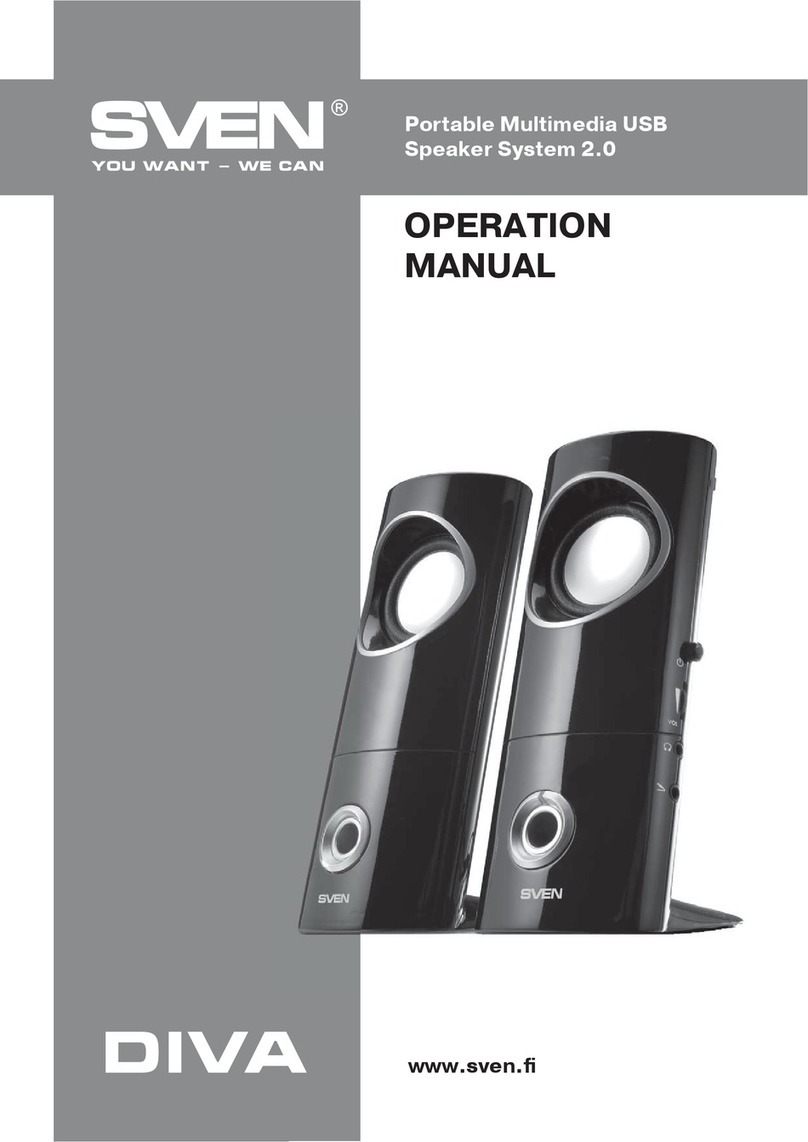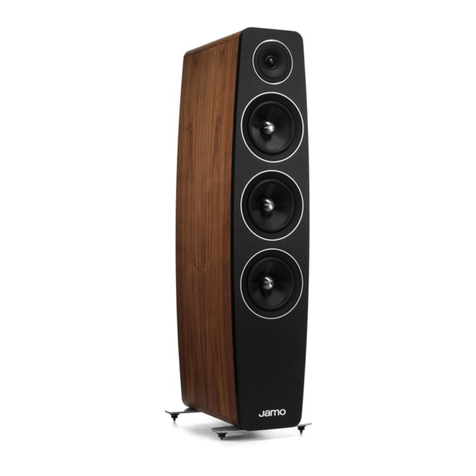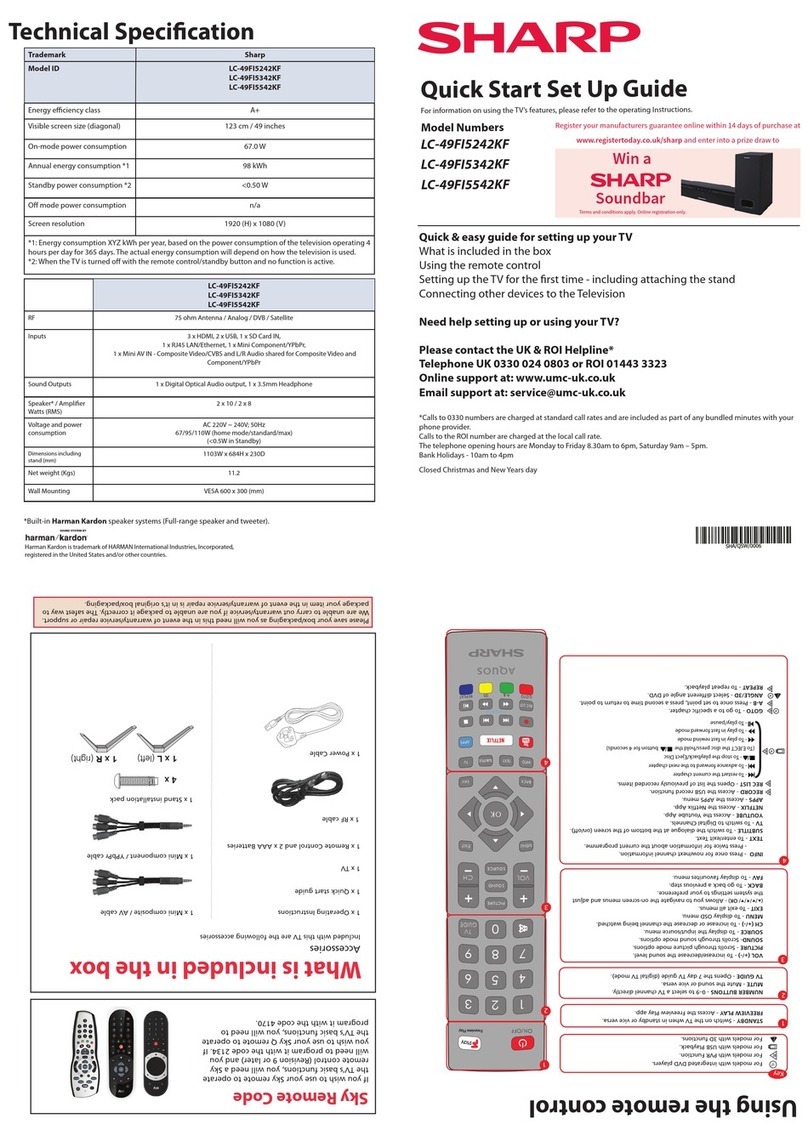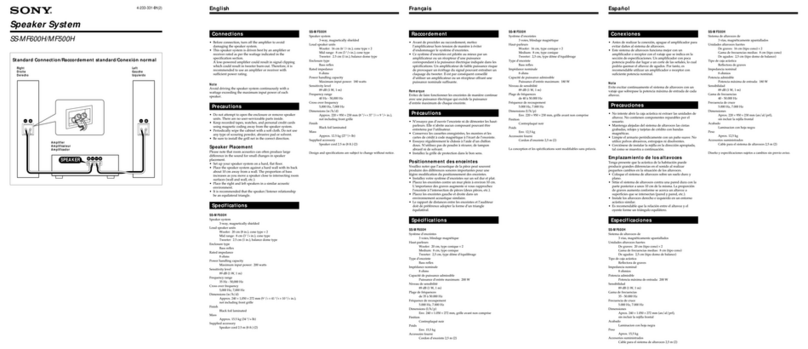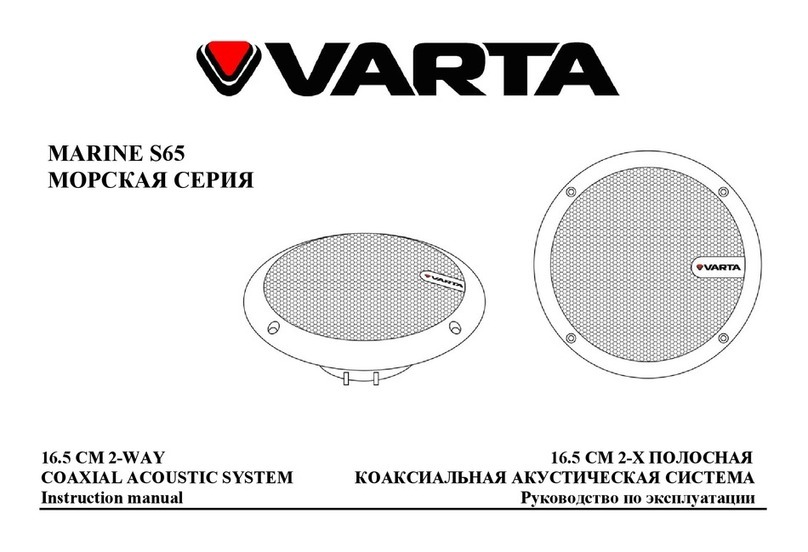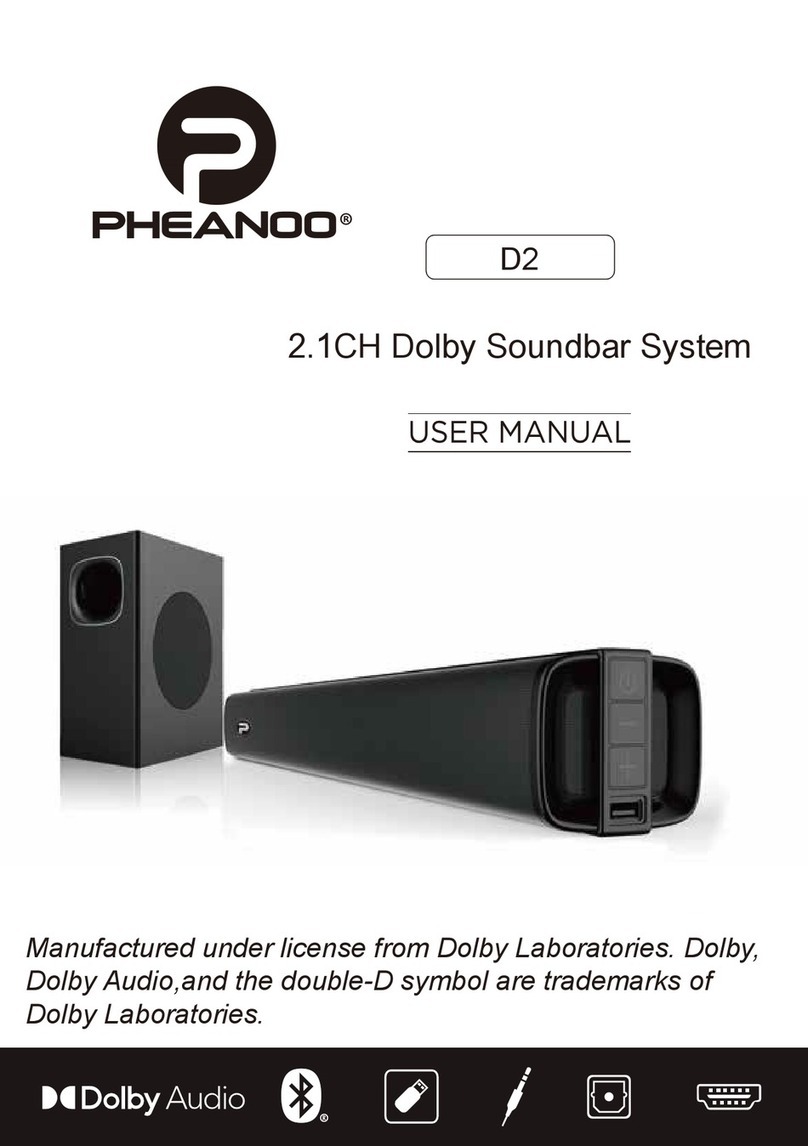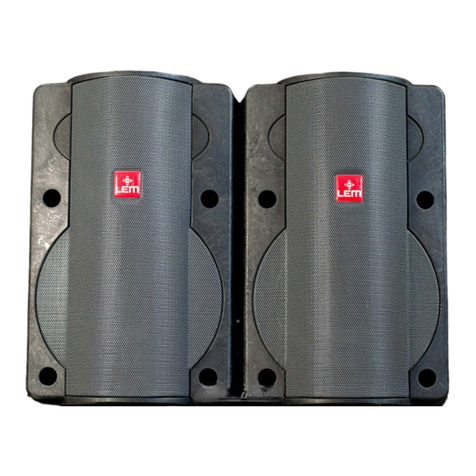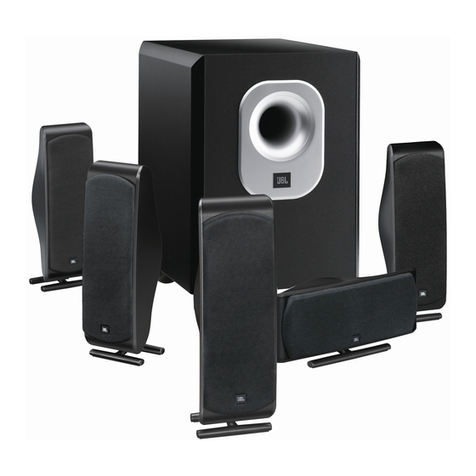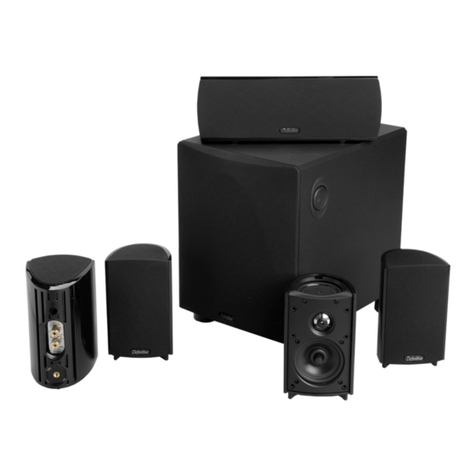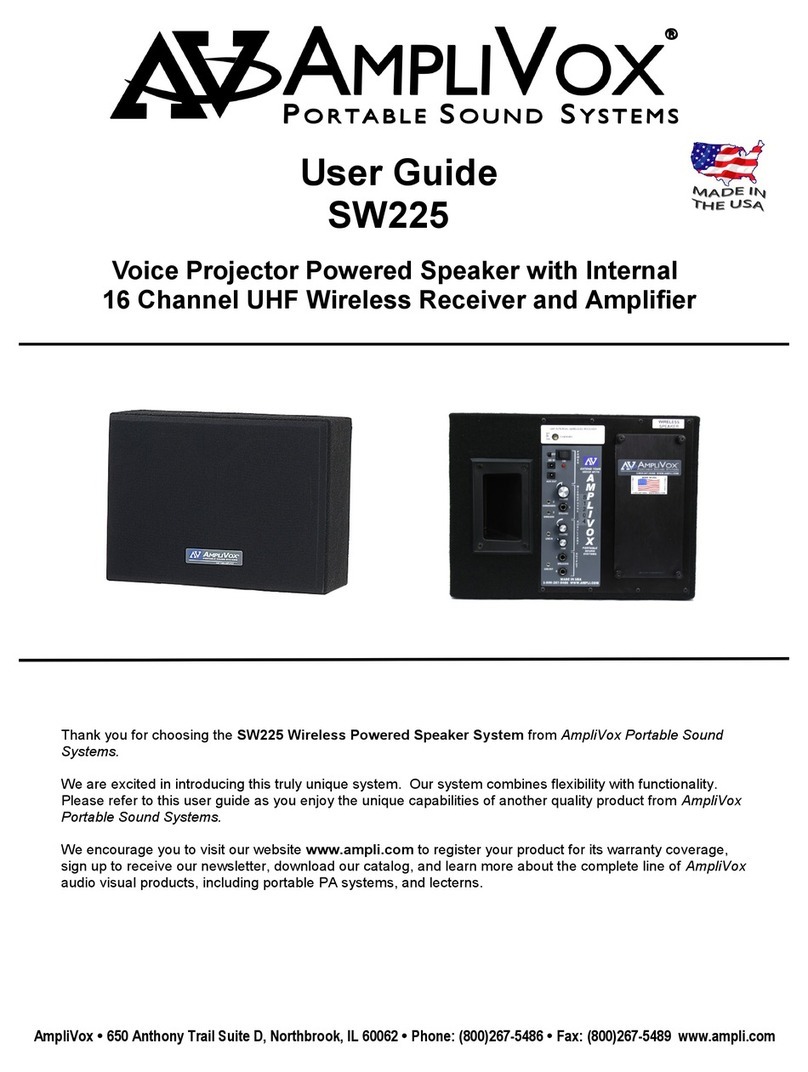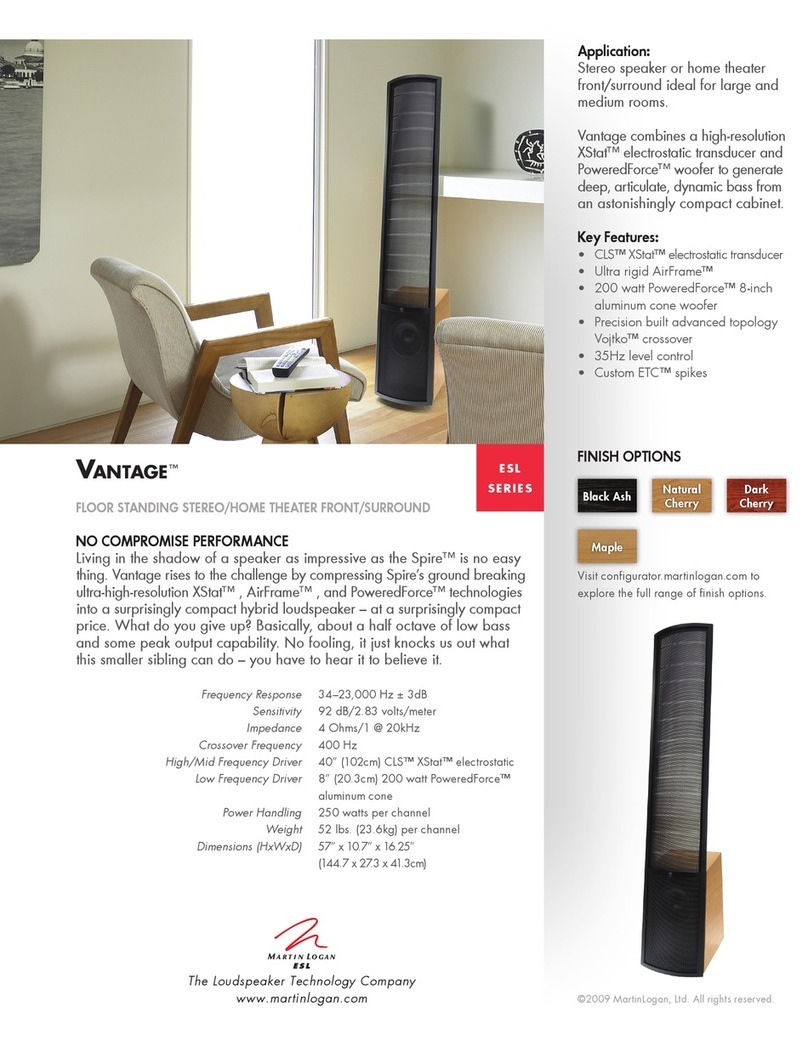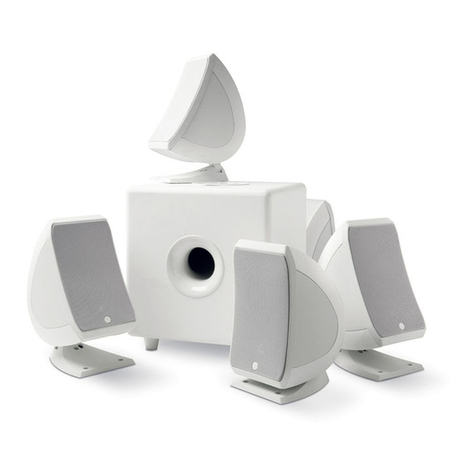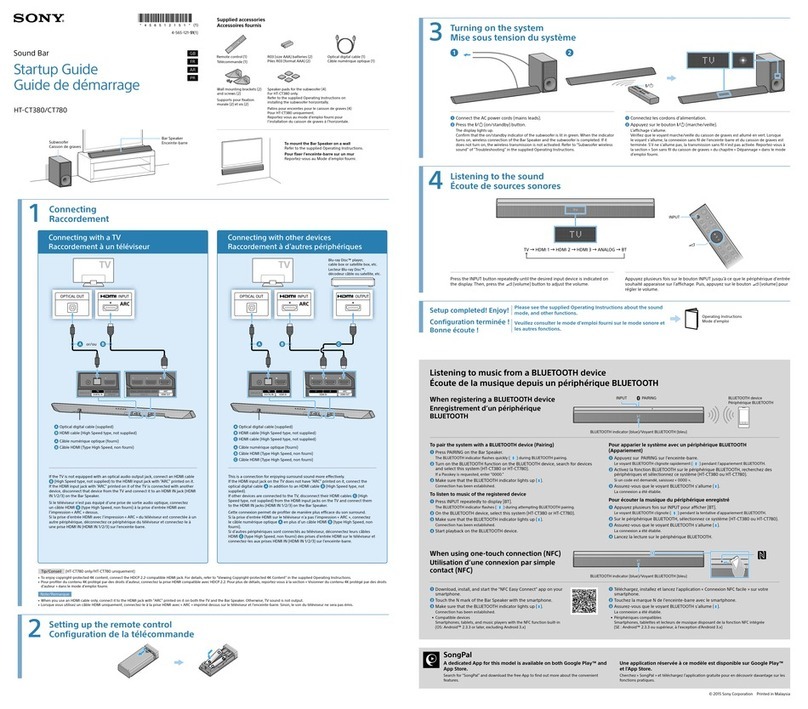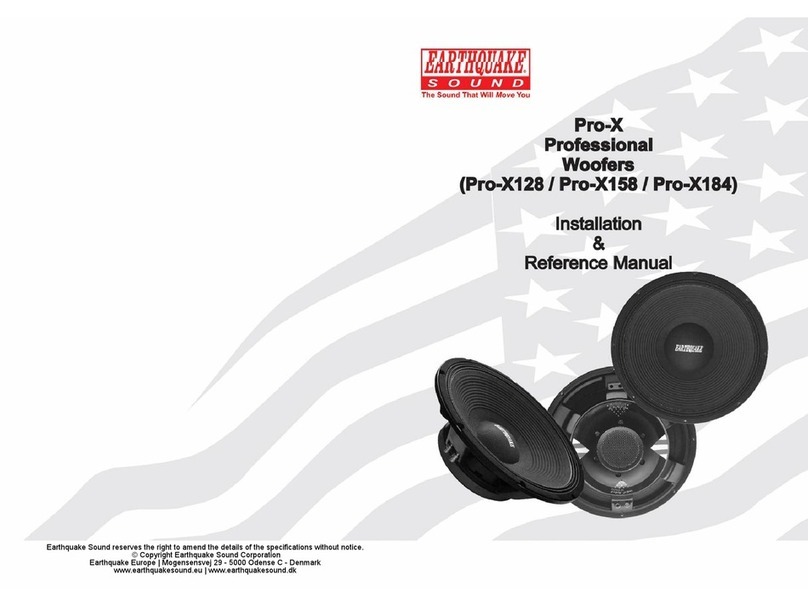Rocket Fish RF-WHTIB User manual

USER'S MANUAL
HTIB WIRELESS SURROUND SPEAKER SYSTEM
RF-WHTIB

Safety Information
CAUTION:
PORTABLE CART WARNING
The lightning flash with arrowhead
symbol within an equilateral triangle
is intended to alert the user to the
presence of uninsulated "dangerous
voltage" within the product's
enclosure that may be of sufficient
magnitude to constitute a risk of
electric shock to persons.
The exclamation point within an
equilateral triangle is intended to
alert the user to the presence of
important operating and maintenance
(servicing) instructions in the
literature accompanying the appliance.
TO REDUCE THE RISK OF ELECTRIC SHOCK:
DO NOT REMOVE SCREWS, COVERS OR THE CABINENT.
NO USER SERVICING PARTS INSIDE.
REFER SERVICING TO QUALIFIED SERVICE PERSONNEL.
FCC
This device complies with Part 15 of the FCC
Rules Operation that is subject to following two
conditions:
(1) This device may not cause harmful interference
and,
(2) This device must accept any interference
received, including interference that may
cause undesired operation.
Warning: Changes or modifications to this
unit not expressly approved by the party
responsible for compliance could void the
user authority to operate the equipment.
Proper Ventilation
To avoid risk of electric shock and fire, and to
prevent damage, locate the apparatus as follows:
Front: No obstruction and open spacing.
Sides / Top / Back: No obstruction should be
placed in the areas shown by the dimensions
below.
10.Do not defeat the safety purpose of the
polarized or grounding type plug. A polarized
plug has two blades with one wider than the
other. A grounding type plug has two blades
and a third grounding prong. The wide blade
or the third prong is provided for your safety.
When the provided plug does not fit into your
outlet, consult an electrician for replacement
of the obsolete outlet.
11. Protect the power cord from being walked on
or pinched particularly at plugs, convenience
receptacles, and the points where they exit
from the apparatus. If the power cord is
damaged, it must be repaired by a qualified
repairer.
12. The mains plug is used as the disconnect device
which shall remain readily operable.
13. Only use attachments/accessories specified
by the manufacturer.
14. Use only with a cart, stand, tripod, bracket, or
table specified by the manufacturer, or sold
with the manufacturer, or sold with the
apparatus. When a cart is used, use caution
when moving the cart/apparatus combination
to avoid injury from tip-over.
15. Unplug this apparatus during lightning storms
or when unused for long periods of time.
16.Refer all servicing to qualified service personnel.
Servicing is required when the apparatus has
been damaged in any way, such as power-
supply cord or plug is damaged, liquid has been
spilled or objects have fallen into the apparatus,
the apparatus has been exposed to rain or
moisture, does not operate normally, or has
been dropped.
17. The apparatus shall not be exposed to dripping
or splashing and no objects filled with liquids,
such as vases, shall be placed on the apparatus.
IMPORTANT SAFETY INSTRUCTIONS
To reduce the risk of electrical shock, fire, etc.:
1. Read these instructions.
2. Keep these Instructions.
3. Heed all Warnings.
4. Follow all instructions.
5. Do not use this apparatus near water.
6. Clean only with damp cloth.
7. The ventilation shall not be impeded by covering
the ventilation openings with items, such as
newspapers, table clothes, curtains, etc.
8. Do not place naked flame sources, such as
lighted candles on the appliance.
9. Do not install near any heat sources such as
radiators, heat registers, stoves, or other
apparatus (including amplifiers) that produce
heat.
Bottom: Place on a level surface. Maintain an
adequate air path for ventilation by placing on the
level surface with a height of 10 cm or more.
Note: In case you need to mount the Receiver
onto the wall, install it against the wall as cool air
can travel through the ventilation slots on the unit
and come out from the top when it is wall-
mounted.
Sender
Sender
Receiver
15cm
15cm
15cm 15cm
10cm
10cm
10cm
10cm
15cm 15cm
15cm
15cm 15cm
15cm
15cm 15cm
Receiver
Front View:
Front View:
Side View:
Side View:
18. Please read Rating Labels at the bottom of
the Sender and the Receiver for power input
and other safety information.
WARNING: TO REDUCE THE RISK OF FIRE
OR ELECTRIC SHOCK, DO NOT EXPOSE
THIS APPLIANCE TO RAIN OR MOISTURE.

2-foot Speaker Cord ( 2)
.1.
Introduction
System Overview
Main Features
Packing Contents
Functional Overview (Sender)
Functional Overview (Receiver)
Preparation of the Units
Connecting the Sender
Connecting the Receiver
Basic Operations
Establishing Communication
between the Sender and Receiver Units
Additional Operations
Placing the Receiver
Adjusting the Volume
Troubleshooting
Specification
1
1
1
1
2
3
4
4
5
6
6
7
7
7
8
9
Contents Introduction
System Overview
RF-WHTIB System uses a proprietary 2.4GHz
wireless communication system providing a
superior level of audio quality and interference
resilience.
The System accepts speaker-level inputs, and
so is compatible with a complete range of multi-
channel home theater amplifier system or AV
receivers.
The System transmits low-latency, high fidelity
audio to a wall-powered stereo amplifier that
retrofits existing satellite speakers that come
with the HTIB system.
Listen to Hi-Fi quality stereo sound in any part of
your home without the need to run expensive
cables.
Main Features
2.4GHz wireless sender and receiver
Transmit high quality audio over a radio
frequency communication link
Compact size
Hidden antennas
Low power consumption
Packing Contents
Examine the contents of the box for your RF-WHTIB System.
The box should contain:
Sender
AC Adapter (For Sender) User Manual
Holder (For Receiver)
Receiver

.2. .3.
Functional Overview (Sender)
The Sender transmits audio signals over a 2.4GHz
radio frequency carrier to the Receiver.
Functional Overview (Receiver)
The Receiver receives 2.4GHz wireless Audio
signals from the Sender.
1
Front View:
Rear View:
Bottom View:
Front View:
Rear View:
Bottom View:
6
2 3 45
23 645
1. LED Indicator
2. Power On/Off Button
3. Right Speaker Input Terminals
4. Left Speaker Input Terminals
5. DC IN Jack
6. Connect Button for Pairing
1
87
1. LED Indicator
2. Power On/Off Button
3. Volume Control Dial
4. Connect Button for Pairing
5. Right Surround Speaker Output Terminals
6. Left Surround Speaker Output Terminals
7. Hanging Holes for Wall-Mounting
8. Cable Storage Compartment

.4. .5.
Preparation of the Units
Connecting the Sender
A. Connecting the Sender with Amplifier
Caution: Turn off your amplifier while connecting
the units.
To connect the speaker cords between the
speaker terminals of Sender and your amplifier.
1. Use the supplied speaker cords of 2 feet long.
Sender's Rear Panel
Sender's Rear Panel
Receiver's Rear Panel
Receiver's Rear Panel
Press&Hold Release
Notes:
Make sure the exposed tips of each cord do
not touch each other, and they are fully
inserted into the terminals.
The colors of the speaker cords may vary with
different HTIB systems.
Make sure you connect your amplifier using
the Surround Speaker Terminals only.
B. Connecting the Sender with AC Adapter
Caution: To avoid risk of fire, and to prevent
damage.
Do not use AC adapters except for the supplied
AC adapter.
Do not use the supplied AC adapter for other
equipment.
To a wall outlet.
Plug the AC
adapter only after
your amplifier is
connected to the
Sender.
Connecting the Receiver
A. Connecting the Receiver with Surround
Speakers
To connect the speaker cords between the
speaker terminals of Receiver and your Surround
Speakers.
Case 1 - If connecting to the Surround Speakers
with speaker terminals
1. Use your surround speaker cords (not supplied).
2. Connect the Right speaker terminals of Receiver
to the terminals of your Right Surround Speaker.
(Similarly, connect the Left speaker terminals of
Receiver to the terminals of your Left Surround
Speaker.)
3. Connect the Red (+) and Black (-) terminals of
Receiver with your surround speaker cords.
Connect the other ends of the cords to the
terminals of your surround speakers.
(Each speaker cord consists of two wires in different
colors. Make sure to connect the same type
(+/-) of terminals with the wire in one color.)
Case 2 - If connecting to the Surround Speakers
with fixed speaker cords
Right Surround
Speaker
Left Surround
Speaker
Right Surround
Speaker
Left Surround
Speaker
2. Connect the Right speaker terminals of Sender
to the Right Surround speaker terminals of
your amplifier.
(Similarly, connect the Left speaker terminals
of Sender to the Left Surround speaker
terminal of your amplifier.)
3. Each speaker cord consists of two wires in
different colors. Connect the Red (+) terminals
with the exposed tips of the Black (with White
line) wire, and connect the Black (-) terminals
with the exposed tips of the Black wire.
Surround Speaker Outputs
To a wall outlet.
Connect the AC power
only after all speakers
are connected to the
Receiver.
Cable Hole
1. Connect the fixed speaker cord of your Right
Surround Speaker to the Right speaker terminals
of Receiver.
(Similarly, connect the fixed speaker cord of
your Left Surround Speaker to the Left speaker
terminals of Receiver.)
2. Connect the Red (+) and Black (-) terminals of
Receiver with the fixed speaker cords
respectively.
(Each speaker cord consists of two wires in different
colors. Make sure to connect the same type
(+/-) of terminals with the wire in one color.)
Notes:
Make sure the exposed tips of each cord do
not touch each other, and they are fully
inserted into the terminals.
For more details about connecting speakers, please
see your speaker instruction book.
B. Connecting the Receiver with AC Power
1. Open cover of the cable storage compartment
at the bottom of Receiver.
2. Unwrap the cable and extend it to the desired
length.
3. Close the cover. Make sure the extended
cable is not pinched and comes out from the
cable hole as shown in the diagram.
4. Connect the AC power plug to a wall outlet.

Establishing Communication
between the Sender and Receiver
Units
To power on the System.
a. Press the button on the rear panel of Sender.
The LED indicator blinks to indicate that the
Sender is plugged in and in Standby mode.
b. Press the button on the rear panel of Receiver.
The LED indicator blinks to indicate that the
Receiver is plugged in and in Standby mode.
c. The Sender and Receiver were pre-paired at
the factory. When an active link is established
between them, the LED indicators will be solid
on and will not flash.
Note: In case the indicators continue to blink
after 30 seconds, it means there is no
active link between the Sender and
Receiver. Try to connect the System
manually using the CONNECT button. For
more, please refer to "Troubleshooting" on
page 8.
.6. .7.
Basic Operations Additional Operations
Sender
Receiver
To listen to the System.
a. Make sure the System is powered on, and
there is an active link between the Sender
and Receiver.
b. Turn on your amplifier. Play the audio or video
source at your amplifier. Enjoy using the
wireless audio system!
To power off the System.
a. Press and hold the power button for 2 seconds.
The LED indicator will blink quickly first and
then go off to indicate that the Sender is
powered off.
b. Press and hold the power button for 2
seconds. The LED indicator will blink quickly
first and then go off to indicate that the
Receiver is powered off.
Note: It is acceptable to leave both units powered
on when not in use.
Placing the Receiver
To cope with your different specific needs, the
Receiver can provide you three ways of
placement.
1. Placing the Receiver horizontally on a level
surface.
2. Placing the Receiver vertically with the
supplied holder.
3. Wall Mounting the Receiver
Adjusting the Volume
After the System is set up, it is recommended
that a 1 time adjustment of the Receiver volume
is made.
The volume control on the Receiver unit is only
used to adjust the balance of the volume
between the front and rear speakers.
After the volume of Receiver is set up, always
adjust the volume using the volume control on
your amplifier whenever needed.
Note: The volume control on the rear panel of the
Receiver is only used during the set-up
process to establish the relative volume
between the front and rear speakers.
6cm

.8. .9.
Troubleshooting Specification
Please read this user manual carefully before using the System. Check this list for a possible
troubleshooting solution before calling for service. Sender
Audio Input: Stereo, Speaker-level
Max audio input signal: 20V RMS into 6.6k
Audio Output: Wireless
Stereo, 16-bit, 48KHz, uncompressed
Bit-rate: 1.465Mbps
Raw wireless bit-rate: 2Mbps
Supply Voltage: 5V
Receiver
Audio Input: Wireless
Stereo, 16-bit, 48KHz, uncompressed
Wireless audio system performance
Signal-to-Noise Ratio: 90dB
Total Harmonic Distortion: 0.4% (at 1KHz, Output 2V RMS)
Audio Output: High Efficiency Class D, Speaker-level
Support 4 to 8 ohm speakers
Audio output power: RMS: 2 x 25W per channel into 4 ohms (no more than 10% THD)
High Efficiency Class D Output
No Sound Output
Interference in the Sound
No communication between
Sender and Receiver
Check the AC adapter is connected to the Sender and
power cord is connected to the AC supply for the
Receiver.
Check all the cables are connected correctly. Check to
see if the LEDs illuminate on the front of both the
Sender and Receiver units. If the LEDs are lit solidly
then the communication is working correctly and all
speaker wires and the amplifier operation should be
checked. If the LEDs are flashing then follow through
the "no communication between Sender and Receiver"
section below.
Move your Sender and Receiver slowly to find the best
reception position for your System.
Shorten the distance between your Sender and Receiver. The
maximum distance is 100 feet.
Check if there are any obvious radio frequency interference
sources near your System.
Check the power cords of the System are connected
correctly.
Once the power buttons have been pressed to turn on
both the Sender and Receiver units, the front panel
LEDs should illuminate. If they are solidly on then a
communication link has been successfully established
between the units. If they are flashing on one, or both,
units then press and hold the CONNECT button on
either the Sender or Receiver for 2 seconds. (The
Sender's CONNECT button is at its bottom and the
Receiver's CONNECT button is on its rear panel.) This
will put the unit into the "connection mode" for about 30
seconds. During this period the CONNECT button on
the other unit must also be pressed for 2 seconds so
that it will also enter the "connection mode". Then, the
System proceeds with the connection process between
the Sender and Receiver. During the "connection
mode", the LED indicators blink at a faster rate. When
an active link is established between the Sender and
Receiver, the LED indicators will be solid on and will not
flash.
Note: Try pressing the CONNECT buttons again if the
LED indicators keep blinking after 30 seconds.
Problem Solution
Other manuals for RF-WHTIB
4
Table of contents
Other Rocket Fish Speakers System manuals
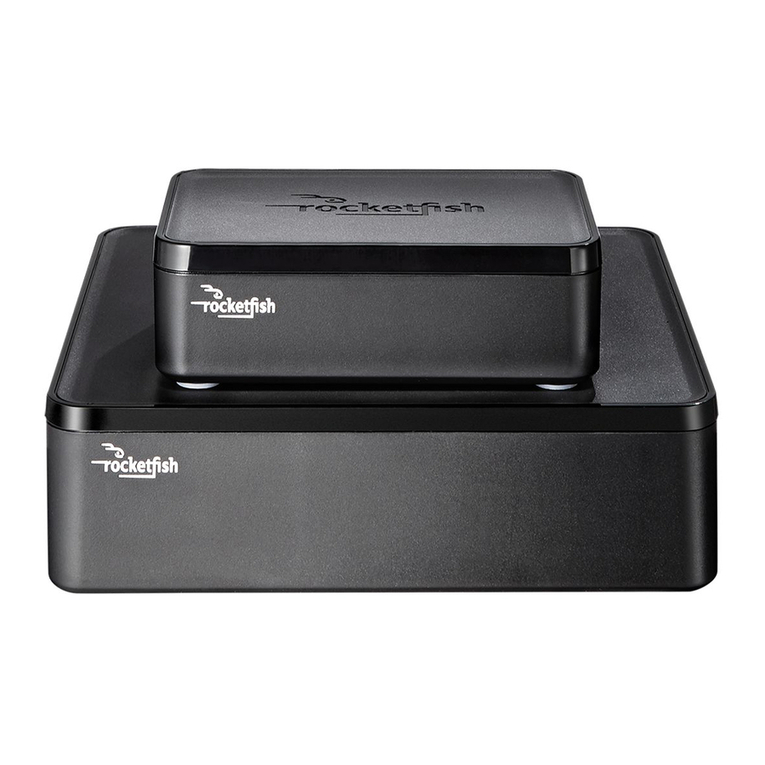
Rocket Fish
Rocket Fish RF-WHTIB-A User manual
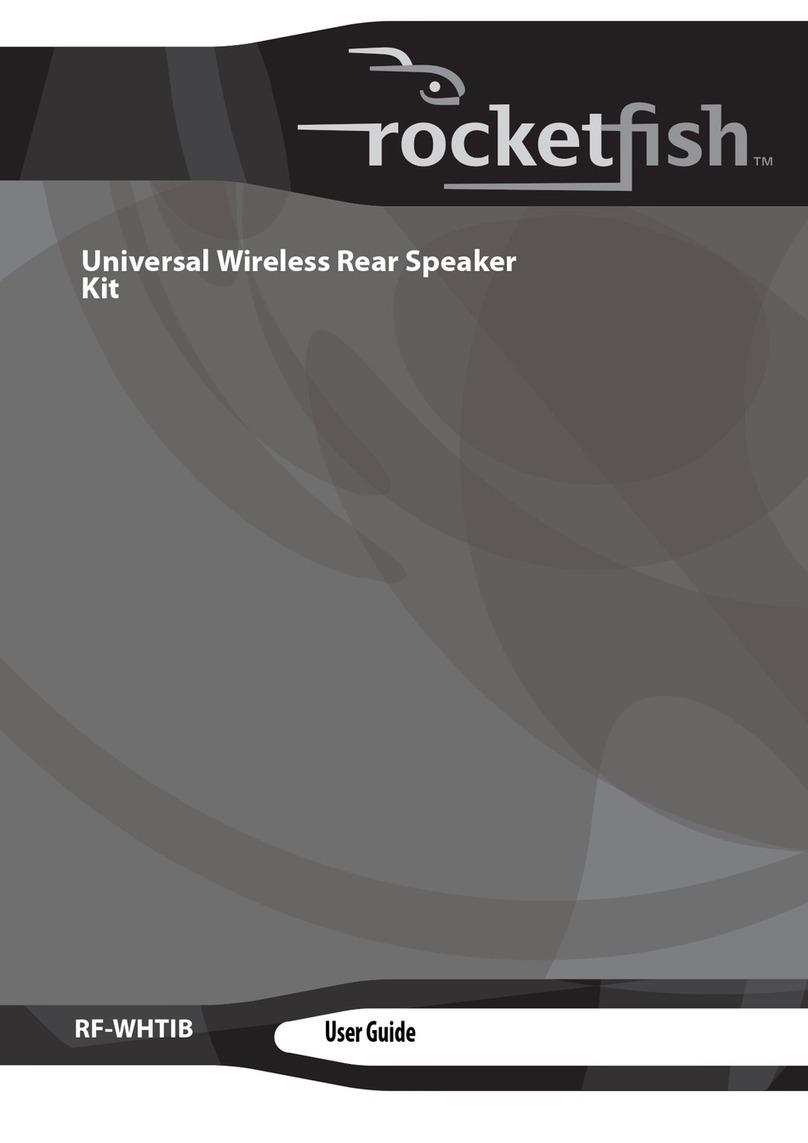
Rocket Fish
Rocket Fish RF-WHTIB User manual
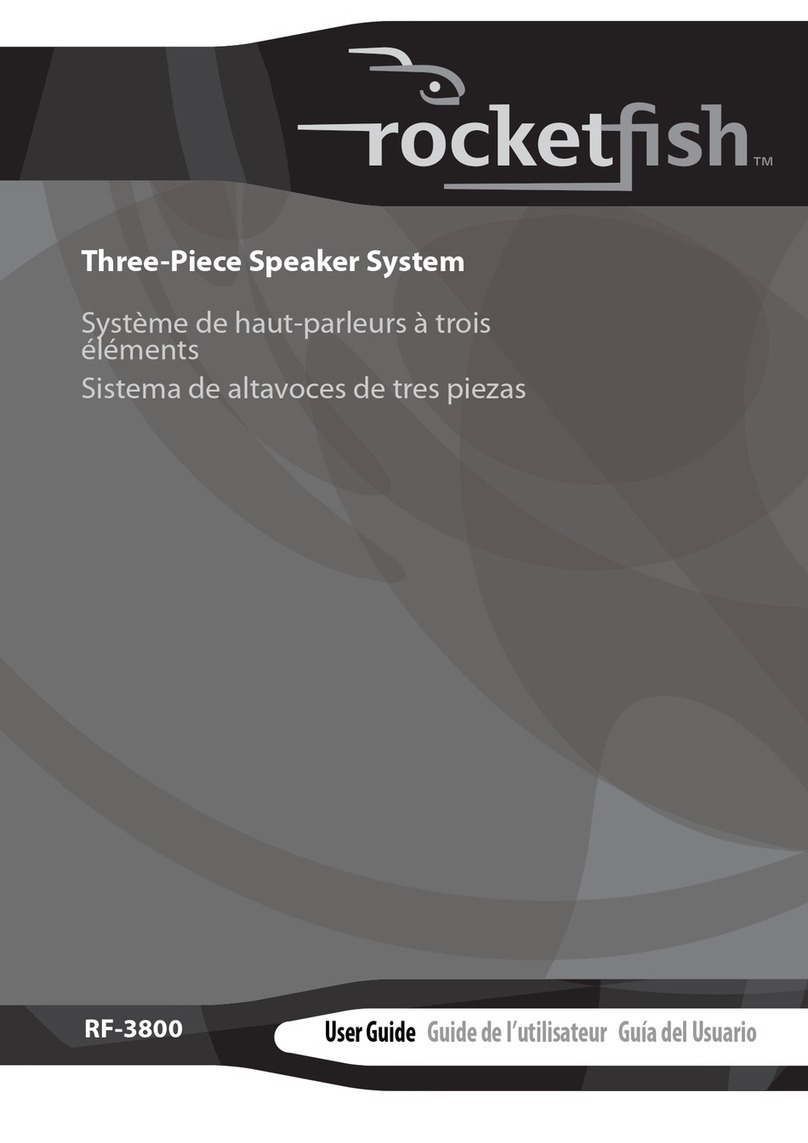
Rocket Fish
Rocket Fish RF-3800 User manual

Rocket Fish
Rocket Fish RF-WHTIB Quick start guide
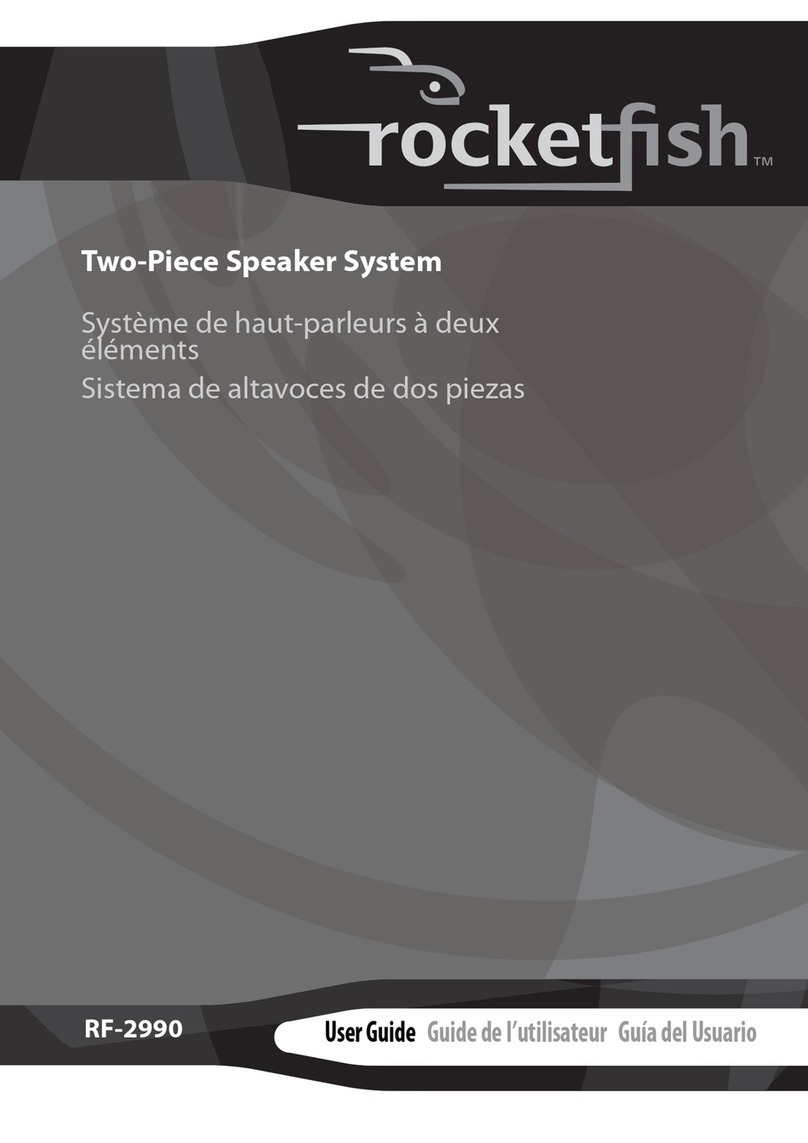
Rocket Fish
Rocket Fish RF-2990 User manual

Rocket Fish
Rocket Fish RF-WHTIB Quick start guide

Rocket Fish
Rocket Fish RF-WHTIB User manual
